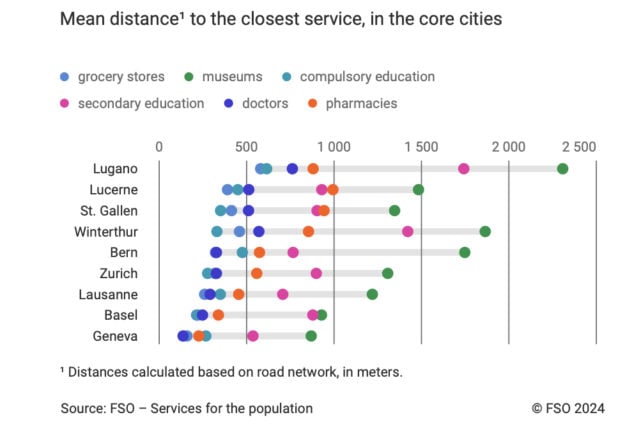The concept of life quality is difficult to define, and much depends on the criteria used to make this determination.
But a new study released this week by the Federal Statistical Office (FSO) sheds some light on which Swiss cities are the best to live in, based on several different indicators.
The ‘City Statistics’ survey has measured and compared the well-being of residents of nine Swiss cities : Basel, Bern, Geneva, Lausanne, Lucerne, Lugano, St. Gallen, Winterthur, and Zurich.
City Portraits 2023 #statistics https://t.co/QJuH8XDnSM pic.twitter.com/uhfPREBuOI
— Swiss Statistics (@swissstatistics) January 23, 2024
What did the study find?
The study is quite detailed and in-depth, covering 11 mutually interdependent indicators relating to material living conditions, but also to the subjective perception of quality of life.
An important take-away message here is that there is no one clear ‘winner’ (or loser) — while one city could do better in certain categories, others ‘outperform’ it in others.
Let’s look at some of them.
Income
This is obviously a key indicator because, according to FSO, it “allows people to cover their basic needs and provide opportunities to fulfil personal wishes”. The statistics office adds: “They allow people to accumulate wealth, helping them be more resistant in times of economic crisis.”
In this respect, Zurich is in the first place, with an average taxable income — that is, the amount subjected to tax, after deductions and exemptions— of 70,000 francs a year.
Next is Basel (sightly less than 70,000 francs), followed by Geneva, Lausanne and Lugano (all three just over 60,000).
Housing conditions
According to FSO, “good housing conditions meet the basic needs of people for safety, feeling of protection, privacy and personal space. How-ever, housing costs can take up a large part of a household’s budget, limiting expenditure on other areas.”
In this particular category, the study looked at where the population is regularly disturbed by noise preventing them from getting a good night’s sleep.
Geneva is the winner (or, rather, the loser) in this category, because nearly 45 percent of study participants report that outside noise keeps them awake at night.
Lucerne, Zurich, Basel, and Lausanne, meanwhile, are quietest and most sleep-friendly.
The ‘quietest’ city is St. Gallen, where the vast majority (90 percent) of residents enjoy the sound of silence.
Mortality rate among people under 65
Switzerland has one of the highest life expectancies in the world, and the population is generally healthy, but some people do die while relatively young.
Here, the study looked at mortality rates caused specifically by “diseases of the circulatory or respiratory systems per 100,000 inhabitants”.
In this category, residents of Basel and Winterthur are worst off, with about 25 percent of the population falling under these criteria.
On the other hand, Geneva has the lowest proportion (about 18 percent) in this category.
Crime rate
This is an important indicator of quality of life (or lack thereof) because “crime may lead to a loss of possessions, physical suffering, stress and anxiety. It may also influence residents’ feeling of security,” according to the FSO.
Here, the office examined the number of burglaries per 1,000 inhabitants.
Geneva is at the top of rankings, with almost five break-ins per year per 1,000 people.
Next is Basel (3.5). Lugano is the safest city, with only one burglary per 1,000 inhabitants in a span of a year.
READ ALSO: Which parts of Switzerland have the highest (and lowest) violent crime rates?

Work-Life-Balance
“A good work-life-balance influences well-being, contributes to productivity in the workplace, and helps people to remain healthy and happy,” the FSO said.
Under this category, the office examined the availability of childcare per 1,000 pre-school age children.
Zurich did better than other cities, with 550 places available in the city.
Next is Lausanne, with just over 500 places, and Basel (a little over 400).
All the other cities fall under the 400-mark, with St. Gallen getting the lowest score (210).
Infrastructure and services
Needless to say, this is important because good (or bad) infrastructure impacts positively (or negatively) many aspects of quality of life.
The study looked specifically at the at the mean distance to the closest services in each city.
For instance, as this colour-coded FSO chart indicates, if we take Lugano, the nearest grocery store, primary school, medical facility, and pharmacy are all located within 1,000 metres from residence.
A secondary school and a museum, however, are farther afield, between 1,750 and 2,500 metres, respectively.

In conclusion, the study shows that there is no one ‘winner’ in terms of overall quality of life, but each city’s ranking depends on a variety of factors. Some of which may be more important to you or your family.
You can download the entire study from the FSO website.



 Please whitelist us to continue reading.
Please whitelist us to continue reading.
Member comments